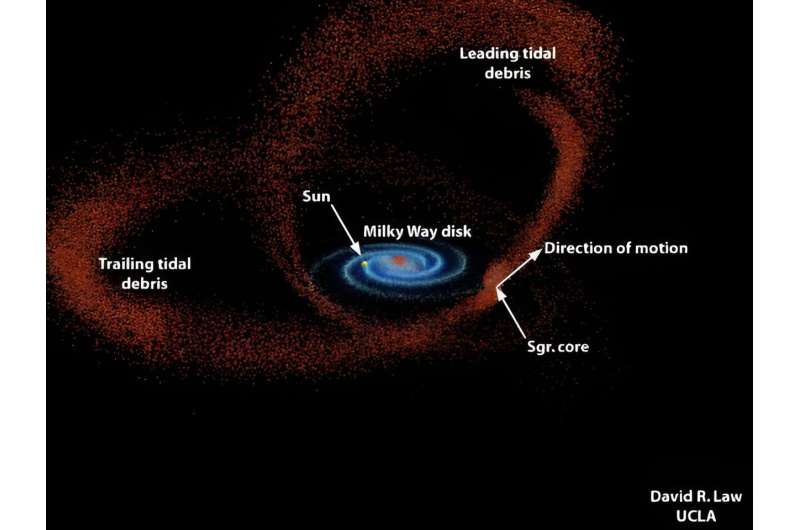This article has been reviewed according to Science X's editorial process and policies. Editors have highlighted the following attributes while ensuring the content's credibility:
fact-checked
peer-reviewed publication
trusted source
proofread
The Milky Way's stolen globular clusters

Modern astronomy holds that all major galaxies (with the Milky Way as no exception) are the accumulation of numerous small mergers. Thus, it should be expected that some of the globular clusters that are now part of our galaxy are likely inherited from other galaxies which have been cannibalized by the Milky Way, or even stolen from intact companion galaxies such as the Magellanic Clouds.
Associations between these clusters and the various progenitors began in the 1990s, but recent research is beginning to paint a more comprehensive picture on exactly what percentage of our globular clusters were stolen, and precisely which ones.
History
The Milky Way is host to a large number of satellite galaxies. This includes the famous Magellanic clouds, but also includes less well known such as the Fornax dwarf and the Antlia II dwarf.
But not all of these dwarf galaxies are so independent. Several, such as the Sagittarius dwarf galaxy, discovered in 1994, are notably elongated or distorted—more long streams of stars than organized galaxies. This suggests that they are currently being tidally torn apart and are in the process of merging into the Milky Way.
Discoveries of these streams of tidally disrupted systems offered a potential solution for the puzzling observation: Many of the globular clusters surrounding our galaxy have a similar age, while others are relatively young. Astronomers began suggesting it was because these younger clusters were formed in these relatively young dwarf galaxies.
Slowly, evidence for this argument accumulated. In 2002, astronomers studying the globular cluster NGC 5634 realized that its position was in the tidal stream of the Sagittarius dwarf galaxy. Its motion and metal-poor composition also matched the rest of the dwarf galaxy.
Since then, astronomers have found compelling evidence that several additional globular clusters are also associated with this tidally tortured galaxy. This includes AM 4, Arp 2, Pal 12, NGC 2419, NGC 4147, Terzan 7, Terzan 8, Whiting 1.
In the meantime, other streams of torn apart dwarf galaxies were discovered, including the Helmi stream, the Gaia-Enceladus Sausage, the Sequoia galaxy, among others. Associations with additional globular clusters soon followed.
In addition to galaxies currently undergoing cannibalization, astronomers have also proposed that some of the more intact dwarf galaxies orbiting the Milky Way may have contributed globular clusters (as well as potentially poaching some of their own).
Recent research
In a recent series of papers, astronomers at the Institute for Advanced Studies in Basic Sciences in Iran, have taken a different approach, looking at how the various galaxies surrounding and being absorbed into the Milky Way may swap globular clusters.
In their first paper published in Monthly Notices of the Royal Astronomical Society, they modeled hypothetical dwarf galaxies (populated with globular clusters) in various orbits around the Milky Way to explore how easily their clusters could be separated from their host galaxy.
They found that the percentage of clusters pulled off varied anywhere from 12% to 93%. The clusters were more likely to be extracted if they had elliptical orbits that took them into the outskirts of their host galaxies. However, if the galaxy was more massive, it would be able to hold on to its clusters better.
Based on this range of simulations, the paper suggested that at least two globular clusters would have been the Fornax galaxy, four from the Large Magellanic Cloud, two from the Small Magellanic Cloud, and 14 from the Sagittarius dwarf galaxy.
In their second paper, also published in Monthly Notices of the Royal Astronomical Society, they approach the question from the opposite direction, examining the orbital properties of 154 globular clusters and comparing them with the properties of 41 dwarf galaxies known to orbit the Milky Way, as well as some of the tidally disrupted systems
Using purely these kinematic properties, the authors identified 14 globular clusters associated with the Sagittarius dwarf galaxy, in good agreement with the previous paper. However, their findings disagree with other studies on exactly which clusters they were.
Five of the clusters previously associated with the Sagittarius dwarf galaxy the authors found did not share sufficient parameters to be considered as likely to have been stolen.
However, they identify four new globular clusters not previously associated with the galaxy as having a high likelihood of association, as well as six others with a lower likelihood. The study also finds six clusters that were likely taken from the Large Magellanic Cloud.
Ultimately, their review finds that 29 (19%) of the known globular clusters had properties sufficiently similar to the dwarf galaxies reviewed to be considered associated.
The authors do admit that their models are somewhat simplistic, as they do not fully model the complex 3-dimensional structure of the dwarf galaxies. While such computations are possible with modern computers, because the authors ran the simulations numerous times with varying parameters, doing so would still have been challenging.
As such, they leave this open to future research which will also undoubtedly include further investigation into the newly identified associations.
More information: Ali Rostami Shirazi et al, The escape of globular clusters from the satellite dwarf galaxies of the Milky Way, Monthly Notices of the Royal Astronomical Society (2022). DOI: 10.1093/mnras/stac1070
Ali Rostami Shirazi et al, Identifying the possible ex-situ origin of the globular clusters of the Milky Way: A kinematic study, Monthly Notices of the Royal Astronomical Society (2023). DOI: 10.1093/mnras/stad3046
Journal information: Monthly Notices of the Royal Astronomical Society
Provided by Universe Today





















